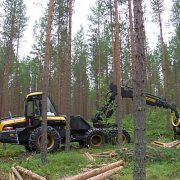Tag Archive for: Ponsse
Towards more sensitive forest operations– TECH4EFFECT conducted field trials with forwarders and flotation tracks
The TECH4EFFECT (Knowledge and Technologies for Effective Wood Procurement) project successfully conducted field trials near Rautavaara, Finland, on the impacts of different tracks and machines on the soil. The field tests were conducted during the last week of June 2019 by the project partners Luke, NIBIO and Ponsse in cooperation with contractors and their operators as well as Metsähallitus.
Eight researchers, four operators and representatives of Ponsse were working on the site in soft soil peatland. The researchers conducted measurements on the soil and on the machines.
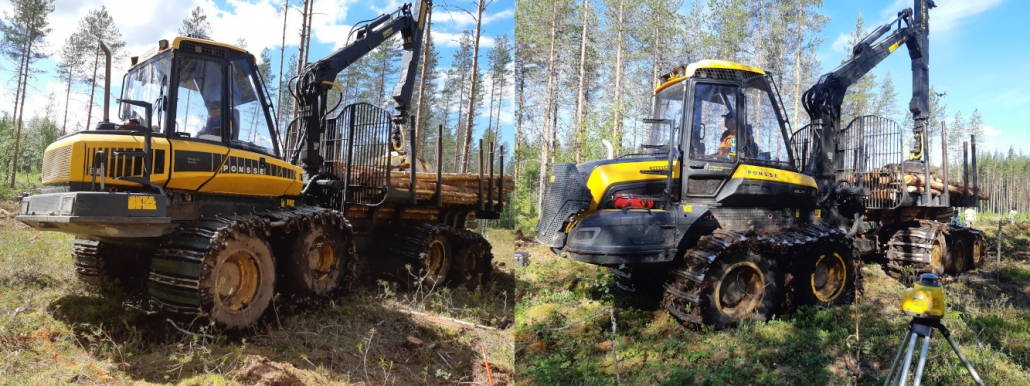
The aim of the field test was to study the effects of different machine and track combinations on wheel rut development and fuel consumption on soft soil. 5 different track types were tested. The impact was measured as the depth of any ruts developed over multiple passes, both while driving straight and through a curve of 20 m radius. The trial was also used to evaluate different methods of measuring soil displacement, including a horizontal laser and measuring stick, a personal laser scanner (PLS) fitted on a backpack, and the use of a digital surface model from derived from an unmanned aerial vehicle (UAV) flown at low altitude. Results of both the track and machine combinations, and the measurement methods will be analysed and disseminated in autumn.
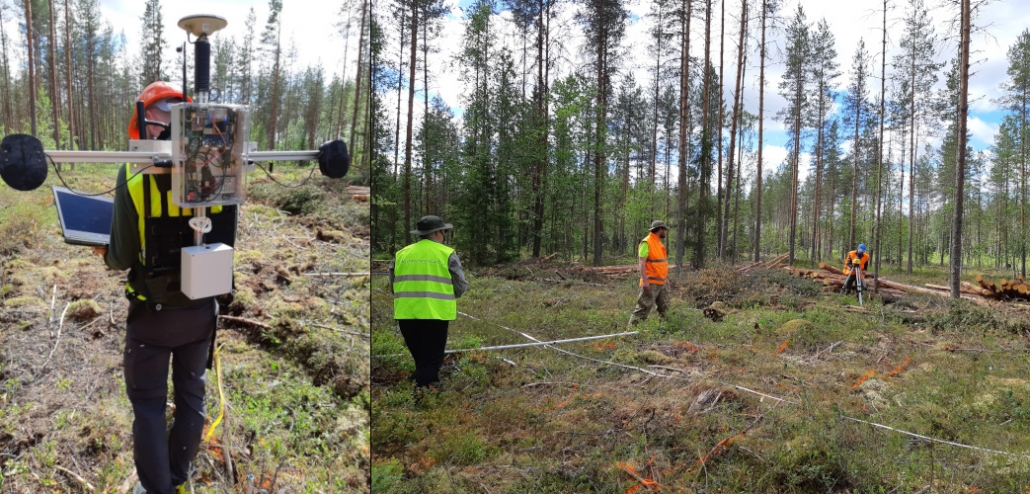
Ponsse forwarder loading
Ponsse 8-wheeler Wisent forwarder loading during thinning operations in Joensuu, Finland
Ponsse harvester- multi-stem processing
Ponsse Scorpion harvester with a multi-stem processing harvester head in action during thinning operation in Joensuu, Finland
Publication: Modifying the settings of CTL timber harvesting machines to reduce fuel consumption and CO2 emissions
Following extensive field trials, LUKE just published results on experiments with Ponsse harvesters:
- Adjustment of machine settings had an effect on fuel consumption and CO2 emissions.
- Large energy saving potential in the Nordic and Baltic regions alone:
- Potential savings may amount to almost 50 million litres of diesel per year.
- Stem size also had a strong effect on fuel consumption and productivity.
Read the abstract or download the full pdf!
Whatch the video produced during the field trials: http://www.tech4effect.eu/fuel-economy-tests-harvesters/
Figure 1: The machines studied in the experiment, upper-left the Ponsse Beaver, upper-right the Ponsse ScorpionKing, below the Ponsse Ergo.
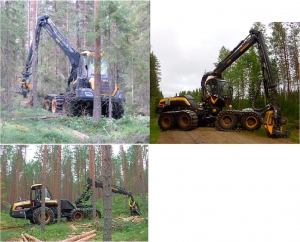
Fuel economy tests – harvesters
In August LUKE, CNR-IVALSA and PONSSE successfully conducted field trials near Jyväskylä, Finland, on the efficiency of cut-to-length harvesting machines in cooperation with a contractor and their operators.
The aim was to reduce the fuel consumption of harvesters during cut-to-length operations by applying various technical settings to the machines, like idle times, engine settings and fine-tuning of hydraulic power supply components. A team of three to seven researchers, three operators and representatives of the manufacturer was working on site, collecting lots of measurements, study data and video material. Three different PONSSE harvesters were studied but similar measures can then also be applied for other machine types, such as forwarders used in timber extraction.
Follow us on Twitter, LinkedIn or ResearchGate or subsribe to our newsletter to be among the first to know about results!
UPDATE! Results publication now available in our publication section: http://www.tech4effect.eu/media-corner/publications/#toggle-id-2
(c) LUKE
Successful TECH4EFFECT field trials with cut-to-length machines to reduce fuel consumption
Project partners LUKE, CNR-IVALSA and PONSSE successfully conducted field trials near Jyväskylä, Finland, on the efficiency of cut-to-length harvesting machines in cooperation with a contractor and their operators. The aim was to reduce the fuel consumption of harvesters during cut-to-length operations by applying various technical settings to the machines, like idle times, engine settings and fine-tuning of hydraulic power supply components.
A team of three to seven researchers, three operators and representatives of the manufacturer was working on site, collecting lots of measurements, study data and video material. Three different PONSSE harvesters were studied but similar measures can then also be applied for other machine types, such as forwarders used in timber extraction.
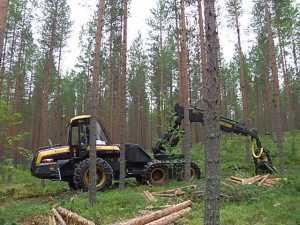
Newsletter
Tweets
Events
 TECH4EFFECT final event highlights research impacts, provides informed dialogue on forest operations19. July 2021 - 12:25
TECH4EFFECT final event highlights research impacts, provides informed dialogue on forest operations19. July 2021 - 12:25 Towards Zero Pollution: TECH4EFFECT presented at the RTDS Green Week Partner Event on 8 June: 10:10 – 12:30.10. May 2021 - 16:18
Towards Zero Pollution: TECH4EFFECT presented at the RTDS Green Week Partner Event on 8 June: 10:10 – 12:30.10. May 2021 - 16:18 TECH4EFFECT Co-ordinator, Rasmus Astrup, presented at EUBCE event19. April 2021 - 15:17
TECH4EFFECT Co-ordinator, Rasmus Astrup, presented at EUBCE event19. April 2021 - 15:17 TECH4EFFECT presents drone mapping, T-winch at Norwegian Ministerial event14. October 2020 - 9:15
TECH4EFFECT presents drone mapping, T-winch at Norwegian Ministerial event14. October 2020 - 9:15


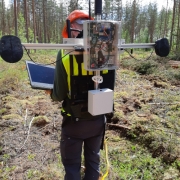
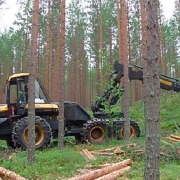 LUKE
LUKE